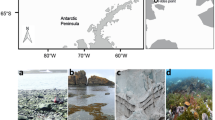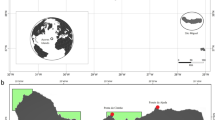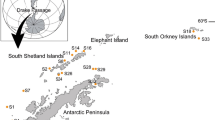Abstract
This work reports and illustrates secondary colonisation of Hexaplex (Trunculariopsis) trunculus shells by polychaetes in the Ria Formosa lagoon (Algarve coast—southern Portugal). Information is presented in terms of qualitative and quantitative data on epibiotic polychaetes, fouling frequency, degree of epibiosis, preferential areas for colonisation and incidence of shell damages. A total of 2,880 polychaetes belonging to 10 families were identified. Besides Spirorbidae (not quantified), the most abundant families were Serpulidae (67.5%), Sabellidae (10.2%), Sabellariidae (9.6%) and Cirratulidae (8.5%). From a total of 2,264 T. trunculus individuals analysed for epibiosis, 28.4% were non-fouled, 66.8% were intermediately fouled and 4.8% were heavily fouled. The fouling frequency, degree of epibiosis and incidence of damages in the shell spire increased markedly with T. trunculus shell length. Some epibiotic polychaetes were located preferentially on/or nearby particular features of T. trunculus shells, which probably facilitate settlement and tube construction, in addition to provide some protection against tube damage. The main consequences of epibiosis (benefits and disadvantages) for the gastropod basibiont (T. trunculus) are discussed. The present study apparently indicates that besides burrowing into soft bottom substrates, sporadic inter-tidal exposure and mutual predation on epibiosis, T. trunculus lacks other typical antifouling defence adaptations.





Similar content being viewed by others
References
Alyakrinskaya, I. O., 2004. Resistance to drying in aquatic mollusks. Biology Bulletin 31: 299–309.
Alyakrinskaya, I. O., 2005. Functional significance and weight properties of the shell in some molluscs. Biology Bulletin 32: 397–418.
Anon., 2001. Especies de Interés Pesquero en el Litoral de Andalucía. Junta de Andalucía. Consejería de Agricultura y Pesca, Sevilla.
Basedow, T., 1994. Analysis of shells on beaches and rocky coasts of Europe led to new findings on nutritional and population ecology of predatory marine gastropods (Muricidae and Naticidae). Zoologische Beiträge N. F. 36: 29–48.
Basedow, T., 1996. Contributions to the nutritional and population ecology of Murex trunculus (L. 1767) (Gastropoda, Muricidae), derived from findings at the north coast of Crete (Eastern Mediterranean), with remarks on two species of Naticidae (Gastropoda). Zoologische Beiträge N. F. 37: 157–170.
Bell, J. J., 2005. Influence of occupant microhabitat on the composition of encrusting communities on gastropod shells. Marine Biology 147: 653–661.
Bers, A. V. & M. Wahl, 2004. The influence of natural surface microtopographies on fouling. Biofouling 20: 43–51.
Bertrán, C., L. Vargas & P. Quijón, 2005. Infestation of Polydora rickettsi (Polychaeta: Spionidae) in shells of Crepidula fecunda (Mollusca: Calyptraeidae) in relation to intertidal exposure at Yaldad Bay, Chiloe, Chile. Scientia Marina 69: 99–103.
Buckley, W. J. & J. P. Ebersole, 1994. Symbiotic organisms increase the vulnerability of a hermit crab to predation. Journal of Experimental Marine Biology and Ecology 182: 49–64.
Buschbaum, C. & K. Reise, 1999. Effects of barnacle epibionts on the periwinkle Littorina littorea (L.). Helgoland Marine Research 53: 56–61.
Chan, D. H. L. & B. K. K. Chan, 2005. Effect of epibiosis on the fitness of the sandy shore snail Batillaria zonalis in Hong Kong. Marine Biology 146: 695–705.
Corriero, G. & R. Pronzato, 1987. Epibiontic sponges on the bivalve Pinna nobilis. Marine Ecology Progress Series 35: 75–82.
Creed, J. C., 2000. Epibiosis on cerith shells in a seagrass bed: correlation of shell occupant with epizoite distribution and abundance. Marine Biology 137: 775–782.
Dalla Via, G.-F. & U. Tappeiner, 1981. Morphological and functional correlates with distribution of Murex trunculus L. and Murex brandaris L. (Mollusca, Gastropoda) in the northern Adriatic. Bollettino di Zoologia 48: 191–195.
Fauchald, K. & P. A. Jumars, 1979. The diet of worms: a study of polychaete feeding guilds. Oceanography and Marine Biology. An Annual Review 17: 193–284.
Houart, R., 2001. A Review of the Recent Mediterranean and Northeastern Atlantic Species of Muricidae. Ed. Evolver, Rome.
Laudien, J. & M. Wahl, 1999. Indirect effects of epibiosis on host mortality: seastar predation on differently fouled mussels. Marine Ecology 20: 35–47.
Lleonart, M., J. Handlinger & M. Powell, 2003. Spionid mudworm infestation of farmed abalone (Haliotis spp.). Aquaculture 221: 85–96.
Macedo, M. C. C., M. I. C. Macedo & J. P. Borges, 1999. Conchas Marinhas de Portugal (Seashells of Portugal). Editorial Verbo, Lisboa.
Martin, D. & T. A. Britayev, 1998. Symbiotic polychaetes: review of known species. Oceanography and Marine Biology. An Annual Review 36: 217–340.
Muzavor, S. & P. M. Morenito, 1999. Roteiro Ecológico da Ria Formosa, Vol. IV – Moluscos Gastrópodos. Universidade do Algarve, Faro.
Olabarria, C., 2000. Epibiont molluscs on neogastropod shells from sandy bottoms, Pacific coast of Mexico. Journal of the Marine Biological Association of the United Kingdom 80: 291–298.
Poppe, G. T. & Y. Goto, 1991. European Seashells, Vol. 1 (Polyplacophora, Claudofoveata, Solenogastra, Gastropoda). Verlag Christa Hemmen, Wiesbaden.
Rilov, G., Y. Benayahu & A. Gasith, 2004. Life on the edge: do biomechanical and behavioral adaptations to wave-exposure correlate with habitat partitioning in predatory whelks? Marine Ecology Progress Series 282: 193–204.
Spanier, E., 1981. Behavioral ecology of the marine snail Trunculariopsis (Murex) trunculus. In Shuval H. (ed.), Developments in Arid Zone Ecology and Environmental Quality. Balaban ISS, Philadelphia: 65–70.
Spanier, E., 1986. Cannibalism in muricid snails as a possible explanation for archaeological findings. Journal of Archaeological Science 13: 463–468.
Spanier, E. & N. Karmon, 1987. Muricid snails and the ancient dye industries. In Spanier E. (ed.), The Royal Purple and the Biblical Blue: Argaman and Tekhelet. Keter Publishing House Jerusalem Ltd., Jerusalem: 179–192.
Stachowitsch, M., 1980. The epibiotic and endolithic species associated with the gastropod shells inhabited by the hermit crabs Paguristes oculatus and Pagurus cuanensis. P. S. Z. N. I. Marine Ecology 1: 73–101.
Vasconcelos, P., M. B. Gaspar, A. M. Pereira & M. Castro, 2006. Growth rate estimation of Hexaplex (Trunculariopsis) trunculus (Gastropoda: Muricidae) based on mark/recapture experiments in the Ria Formosa lagoon (Algarve coast, southern Portugal). Journal of Shellfish Research 25: 249–256.
Wahl, M., 1989. Marine epibiosis. I. Fouling and antifouling: some basic aspects. Marine Ecology Progress Series 58: 175–189.
Wahl, M., 1996. Fouled snails in flow: potential of epibionts on Littorina littorea to increase drag and reduce snail growth rates. Marine Ecology Progress Series 138: 157–168.
Wahl, M. & H. Sönnichsen, 1992. Marine epibiosis. IV. The periwinkle Littorina littorea lacks typical antifouling defences – why are some populations so little fouled. Marine Ecology Progress Series 88: 225–235.
Wahl, M. & O. Mark, 1999. The predominantly facultative nature of epibiosis: experimental and observational evidence. Marine Ecology Progress Series 187: 59–66.
Wahl, M., M. E. Hay & P. Enderlein, 1997. Effects of epibiosis on consumer–prey interactions. Hydrobiologia 355: 49–59.
Warner, G. F., 1997. Occurrence of epifauna on the periwinkle, Littorina littorea (L.), and interactions with the polychaete Polydora ciliata (Johnston). Hydrobiologia 355: 41–47.
Acknowledgements
The authors would like to thank the technical staff of IPIMAR—CRIPSul for their help in the laboratory sampling procedures. Thanks are also due to Dr. Paula F. Pereira and MSc. Fábio Pereira for their assistance in the taxonomic identification of polychaetes. This study was partially funded by a PhD grant from the Fundação para a Ciência e Tecnologia (FCT: SFRH/BD/5139/2001).
Author information
Authors and Affiliations
Corresponding author
Additional information
Handling editor: K. Martens
Rights and permissions
About this article
Cite this article
Vasconcelos, P., Cúrdia, J., Castro, M. et al. The shell of Hexaplex (Trunculariopsis) trunculus (Gastropoda: Muricidae) as a mobile hard substratum for epibiotic polychaetes (Annelida: Polychaeta) in the Ria Formosa (Algarve coast—southern Portugal). Hydrobiologia 575, 161–172 (2007). https://doi.org/10.1007/s10750-006-0367-x
Received:
Revised:
Accepted:
Published:
Issue Date:
DOI: https://doi.org/10.1007/s10750-006-0367-x




